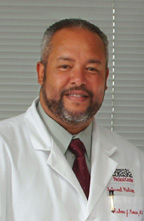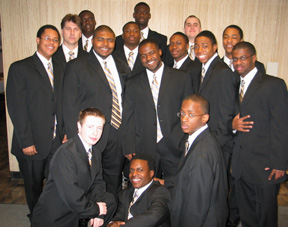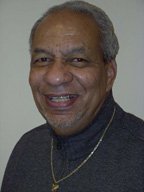The UNMC/The Nebraska Medical Center 2005 Black History Month program held last month featured two of Omaha’s authorities on African American health disparities. Their respective conversations covered the issue from a stark review of numbers to historical perspectives on community response.
 |
Rubens Pamies, M.D. |
The Dec. 22, 2004, issue of the Washington Post included an article on research study results published in that month’s issue of the American Journal of Public Health. The journal noted that 886,000 deaths could have been prevented from 1991 to 2000 if African-Americans had received the same level of health care as whites. The study estimated that technological improvements in medicine – including better drugs, devices and procedures – averted only 176,633 deaths during the same period.
Steven H.Woolf, M.D., lead author of the study and director of research at Virginia Commonwealth University’s Department of Family Medicine, said, “That means that five times as many lives can be saved by correcting the disparities [in care between whites and blacks] than in developing new treatments.”
Dr. Pamies, co-author with former U.S. Surgeon General David Satcher of a soon-to-be-published book on health disparities, explained how widespread the disparities are, the complex nature of analyzing why they exist and how to repair the inequities. He quoted from a 2002 report from the Institute of Medicine (IOM) that “Racial and ethnic minorities tend to receive a lower quality of healthcare than non-minorities, even when access-related factors such as a patient’s insurance status and income are controlled. The sources of these disparities are complex, are rooted in historic and contemporary inequalities, and involve many participants at many levels. [For example], The IOM study committee focused part of its analysis on the clinical encounter itself and found evidence that stereotyping, biases and uncertainty on the part of healthcare providers can all contribute to unequal treatment.”
What is clear, Dr. Pamies, said, is America’s changing demographics and the shortage of minority health professionals in virtually every field. By 2050, people of color will constitute the majority of American citizens. Five states already have people of color as the majority of the state and 11 more will pass this benchmark in the next 10-15 years.
The Latino population in Nebraska doubled between 1990 and 2000. In California, Latinos are such a large part of the state population, that if all of California’s health professional programs were filled with only Latino students for the next 10 years, there would still be a significant shortage of Spanish-speaking health professionals to serve the population.
“A few years ago, African Americans surpassed the gay community as having the leading deaths by AIDS – in fact, 87 percent of all AIDS cases are now in minority populations,” Dr. Pamies said. “Even more sobering is the ‘silent epidemic’ of black infant deaths. If black infant deaths were subtracted from the total infant mortality numbers, the United States would jump from 15th to third best in infant mortality rates in the world.
 |
The real star of the Black History Month program was the Omaha North High School Men’s Choir. The 14 young men — 12 of whom are African American — wowed the audience with their harmonies and range on four songs with little to no musical accompaniment. |
“More than 108 million children in America have no dental insurance; many thousands of children are living with unnecessary dental pain and tooth loss. Professional care is necessary for maintaining oral health, yet 25 percent of poor children have not seen a dentist before entering kindergarten. In addition, African American, Latino and Native American dentists, combined, barely constitute 5 percent of dentists in the nation.”
The primary factors affecting health disparities are minority status, income and educational levels achieved. Other contributors are lack of health insurance, transportation and distance to nearest health facilities, co-payments, as well as gender, age, nativity and work experience.
“In the end, it’s not what we don’t know that will destroy us, but rather the failure to respond appropriately to what we do know,” Dr. Pamies said. “There are many avenues to attack health disparities. They include improving the education of our children, partnering with historically black colleges and universities to increase the number of students admitted to health professional program; measuring the success of programs focused on identifying and mentoring minority students in high school and college; continuing to import and acknowledge the assistance in international medical graduates; encouraging dentistry to join the efforts to achieve continuous health coverage for all American; and continuing to support the 2003 Institute of Medicine Report on health disparities.”
 |
Frank Peak |
“Black people have struggled for everything we’ve ever received in this country, except the boat ride to America as slaves – that ride was free,” Peak said. “It’s important to realize that there is still not a single course being taught in America on the history of African American contributions to medicine. But when I studied that history, I found many, many listings of black contributions to America’s medical history. Black History Month is an opportunity for all of us to highlight a lot of black contributions that are normally unsung. We have always been involved with American medical history, it’s just that our contributions were chronicled – when noted at all – as a byproduct, rather than being an integral part of the advancement of medicine in this country.”
Peak noted that while many people are aware of the tragic abuse of African American patients in the notorious Tuskegee Syphilis Study (1937 to 1972), few people are aware that an African American, Dr. William Augustus Hinton, perfected the first widely used screening test for syphilis. Perhaps if the U.S. Public Health Service had included Dr. Hinton in its planning for the Tuskegee Study, that project wouldn’t be the anathema it represents to African Americans today. It’s hard to imagine, Peak said, Dr. Hinton endorsing a study designed to withhold knowledge from 600 black men that they had syphilis just so Caucasian health professionals could study their death patterns – and certainly not after penicillin became the globally accepted cure for syphilis by 1945.
As a former member of the Black Panther Party, Peak praised UNMC for hiring him when virtually every other door was closed to him in Omaha. UNMC was the start of his decades-long career in health care advocacy and community work. He was proud of the Black Panther Party’s contributions to health care for African Americans – a history almost never mentioned in public discourse about the highly militant group that existed from 1966 until the mid-1970s.
“The Black Panther party started a number of free medical clinics in the country, a sickle cell anemia foundation, People’s Free Dental Program, People’s Free Optometrist Program, one of the nation’s first free ambulance services, as well as numerous food coops and free breakfast programs,” he said.
Peak said his biggest concern today is that cultural competency – the training of health care professionals to be able to effectively treat all patients – is still perceived as a byproduct of medical education. The implication is that cultural competency isn’t critical to the education of health professionals because many assume they will only be treating Caucasians.
“America is one of the most pluralistic societies in the world today,” Peak said. “I would think that we would just automatically provide a health education system that would allow us to work with all people.”